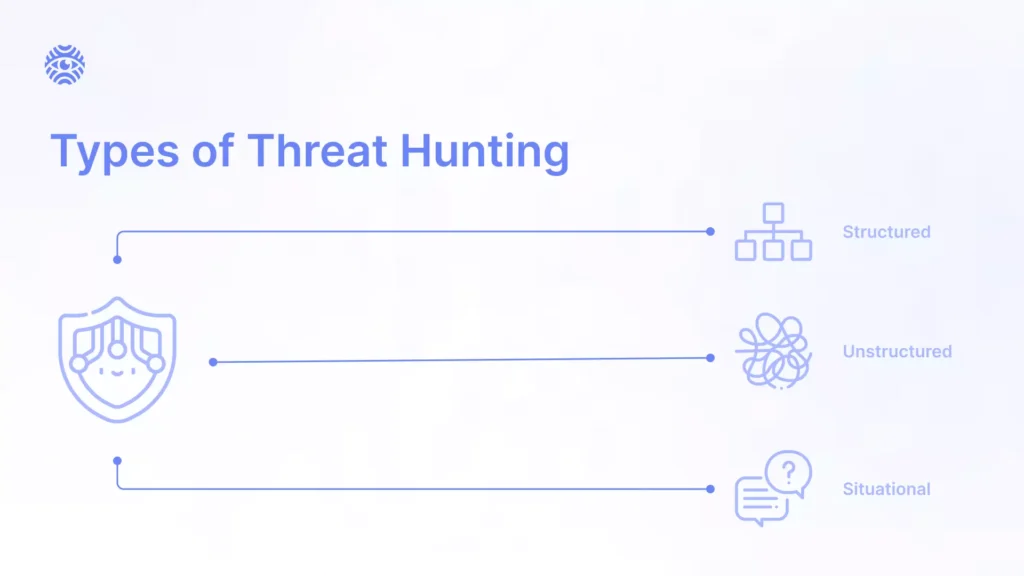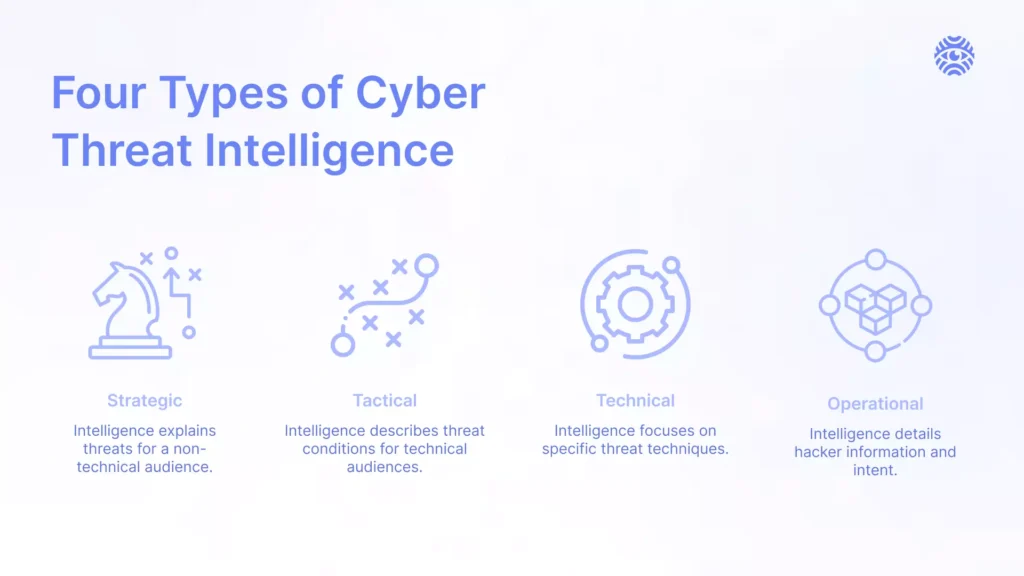Threat intelligence and threat hunting are two components that operate together to strengthen your organization in terms of data security. While intelligence is wired for auditing potential hazards & health of the safety protocols, threat hunting is a dynamic instrument aimed at searching for malicious activity. Let’s dive into how these practices can complement one another in order to make the organization invincible to attacks.
Key Features of Threat Hunting
It is a proactive cybersecurity measure that involves actively lurking for signs of malicious activity within a tech infrastructure. Threat-hunting efforts are about detecting hazards that have gone through the first barriers of defense and penetrated the system. However, threat hunting is not triggered by alerts. Instead, it requires constant searches for potential system disruptors, allowing the firm to point out and uproot issues before they cause any damage.
The Types of Threat Hunting

The inaction of cybersecurity protection depends on the existing infrastructure and instruments of the threat hunting team. Here is an outline of three core categories of these efforts:
- Structured approach. This method is about constant and well-organized analysis of the internal system and external environment. This includes the development of standard operating procedures and the adoption of a clear framework for threat hunts. The structured approach has standard KPIs and a formal procedure playbook.
- Unstructured approach. This practice is all about adaptability and flexibility. Threat hunters have the freedom to explore different techniques and methodologies based on the changes in the hazardous environment. Such threat hunting approach rejects adherence to standard processes since they are more rigid. The use of tools is dynamic and varies depending on the specific needs of the hunt.
- Situational approach. This approach is the most agile way of looking for hazards in the system. Threat hunting teams consider the bigger context of the firm, including industry threats, geopolitical occurrences and specific attacks at similar organizations. The team overviews and uses current threat intelligence reports to stay informed about the novel tactics conjured up by malicious intruders.
The Importance of Having a Threat Hunting Team
The investment of the company in a dedicated threat hunting crew is about always staying vigilant regarding possible hazards. Not sure yet? Consider the following perks:
- Ensuring fast problem investigation. A pro team focused on threat hunting can rather easily assess the scope, cause and origin of the attack. Thus, the firm can adapt and fix the glaring problems or weaknesses that made the organization vulnerable in the first place.
- Reducing dwell time. Threat hunting aims to minimize dwell time of attackers within a network. They can do less harm if a designated threat hunting team contains their impact on the system.
- Boosting the proficiency of SOC. The organization can train and enhance its Security Operation Center if it gains personal practical experience in threat intelligence hunting by searching for and addressing the hazards.
Key Features of Threat Intelligence
The core idea of this instrument is to analyze the intentions and tactics of the offenders. Threat intelligence involves the collection, analysis, and dissemination of information related to potential threats. The primary purpose of this practice is to provide organizations with actionable insights about potential hazards, so they can defend themselves from future cyberattacks.
Threat intelligence hunting activities can include monitoring forums, analyzing malware and studying patterns of attacks, so companies can stay informed about the latest vulnerabilities and exploits.
The Types of Threat Intelligence

Cyber threat intelligence analysts have a variety of approaches tailored to the needs of each specific organization, industry and security problem. Here’s a run through some key branches of threat intelligence:
- Strategic approach. The main concern of this practice is to help the company with long-term threat identification and hazard-related decision-making. It helps senior leadership understand the overall threat landscape with OSINT, make informed investment choices and set organizational priorities. Overall, strategic threat intelligence allows spotting big-scale issues, such as industry trends or geopolitical concerns, even if they might not be apparent right away.
- Tactical approach. The goal of this intelligence domain is to point out who the security attackers are. This practice collects a nuanced database about specific TTPs by malicious actors. As a result, organizations can adapt their security controls to avoid the danger.
- Technical approach. This sphere of threat intelligence helps to cover the technical needs of the organization associated with security dangers. Technical intelligence can enhance security by singling out malware signature indicators.
- Operational approach. This technique aims to inform the security team about short-term incoming threats. It is especially needed for safeguarding industrial control systems and critical infrastructure. An operational approach can be useful for enacting preventive measures to deter potential attackers.
The Importance of Having a Threat Intelligence Team
It is necessary to have threat intelligence experts on board to build the defense barrier of the organization step by step. Some of the benefits are:
- Staying up to date with new threats. Since threat intelligence is all about an in-depth analysis of internal and external hazards, it can help the firm to know the latest cybersecurity trends. Therefore, the company will be aware of the newest phishing techniques and malware attack types.
- Bettering vulnerability prioritization. It is impossible for the organization to prepare for all existing efforts at once. Having detailed and well-structured data collected through threat intelligence activities is crucial for higher-ups to decide what defense actions should be the main priority. It ensures that resources are allocated to address the most dangerous risks.
Who Needs Threat Intelligence and Threat Hunting
The benefits of such checks are important for firms of different scales from a wide range of sectors. Large organizations with huge networks and IT capabilities can have huge gains from threat intelligence and threat hunting to point out and mitigate potential cyber threats. This list includes corporations in finance, healthcare, energy, and other sectors that need detection of safety risks. However, here are some entities that can put intelligence tactics to good use:
- Tech firms. Software developers and IT service providers can reap benefits from threat intelligence and threat hunting to secure their products, networks, and services.
- Critical infrastructure providers. Businesses in critical domains, such as energy, utilities, and transportation, rely on threat intelligence and threat hunting to safeguard their operations. Since disruptions to critical infrastructure can have severe consequences for public safety, having up-to-date intelligence data is a must.
- Financial institutions. It is well-known that banks are prime targets for cyberattacks. Intelligence data can aid these institutions in mitigating risks associated with financial fraud, data breaches, and other cyber threats.
- Healthcare organizations. Healthcare providers deal with sensitive patient information, making them attractive targets for cybercriminals. The features of threat intelligence, along with threat hunts, help healthcare organizations protect patient data from leaks.
How to Combine Threat Hunting and Threat Intelligence Efforts
In order to ensure maximum security of the organization, it is beneficial to merge the features of threat intelligence hunting into one program. Here are things to keep in mind when designing your cybersecurity barriers.
Focusing on One Security Approach
The scale and type of protection should derive from the organization’s needs. Threat hunting efforts can be based on two main approaches that can be used both together and separately:
- A cohesive barrier to protect a system that will deter any actor from entering the system. For example, establish a strong firewall defense to filter and monitor incoming and outgoing network traffic. This measure of security is about making sure that the network is invisible to breaches.
- A scattered minefield designed to catch attackers who have managed to penetrate the system. The organization can deploy decoy threat hunting systems or networks that mimic real assets to lure the hackers. Any activity on these traps indicates a potential security breach and triggers the system to action. Another method is including fake documents or files that, when accessed, turn on alerts and expose the perpetrator. The uniqueness of these measures is that they anticipate cases of intrusion and serve reactively.
Analyzing the Thought Process of Attackers
Threat hunting and threat intelligence operate together effectively if both are based on the logic of anticipating the actions and ideas of the intruder. Some cornerstone predictive measures are:
- Study known evasion techniques used by attackers to avoid detection. Enhance monitoring skills to identify and address these tactics.
- Anticipate attackers’ attempts to blend in with normal system behavior and look for even minor differences compared to normal network operation.
- Design threat scenarios based on likely attacker behaviors. Organize hunts that simulate these cases to evaluate the validity of threat intelligence security protocols.
- Utilize AI algorithms to recognize patterns that point out malicious activity. Train models on previous data to enhance their ability to predict threats in the future.
Identifying the Core Asset in Threat Intelligence Hunting
It is important to deploy long-term focused findings of threat intelligence with the direct effect of threat hunts in order to protect the most valuable asset first. The firm is advised to use insights from both tools to determine what component of the system should be safeguarded with special attention. Moreover, threat intelligence and threat hunting protocols are ought to be tested regularly to determine the risks of breaches, leaks, malware infestation or phishing.
Finding a Balance Between Human and Machine Work
In order to make your system more resilient, mix and match human skills and automation depending on the competencies. Machines excel at processing vast amounts of data, and they can identify patterns, trends, and anomalies in datasets that can be challenging for humans to notice. Humans are well-suited for complex decision-making processes such as ethical dilemmas, moral reasoning, and considering broader implications.
Preparing Cyber Threat Intelligence Analysts
After all, be sure to educate the security team, so they excel in both threat hunting and threat intelligence. Encourage collaboration between different departments within the security team, such as vulnerability management. Provide hands-on experience in simulated environments to allow analysts to practice in realistic threat scenarios.
Conclusion
Even though creating a well-designed threat intelligence and threat-hunting protocol might be a tough task to implement, it is essential for optimizing the health of the security system. The main tip is to clearly define the needs of the organization, audit resources at hand and work step by step based on this vision. Using X-ray Contact as a part of your security defense strategy can be a useful way to find the identities of the attackers and prevent unreliable actors from being allowed to access the network.
